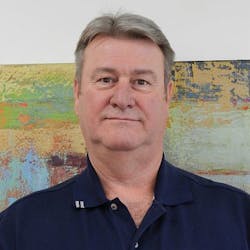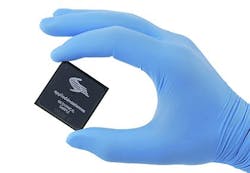Guest viewpoint: the microelectronics DNA marking moral dilemma
PHOENIX, 6 March 2013. In August 2012, a notification was posted on the Defense Logistics Agency Internet Bid Board System (DLA DIBBS) that all FSC 5962 product sold directly to DLA would require DNA marking beginning November 15, 2012.
The Semiconductor Industry Association sent a 12 page response to DLA. DLA did not respond.
In October 2012, the JEDEC JC-13 committee sent a letter with two pages of questions attached for both DLA and Applied DNA Sciences, the company authorized to provide DNA marking on products sold to DLA. JEDEC also officially requested that DLA postpone their implementation of the mandate.
DLA-HQ issued a FAQ that was to answer many of the questions. The FAQ did not address any of the technical questions about the material. DLA also stated that they would not postpone implementation of the mandate.
In January 2013, DLA-HQ made a presentation at the JEDEC DNA marking task group. It was stated that DLA buys approximately $12 million of 5962 product from over 200 sellers; that a directive from the DLA director required that all 5962 product being procured by the DLA have DNA marking on it; and that DLA was researching ways to fund the high cost for suppliers to “buy in” to the DNA marking.
There were representatives of 21 manufacturers of 5962 product at this task group meeting. A straw poll was taken, and of the suppliers represented, 19 were not pursuing DNA marking. Of those 19 companies, 13 stated they would not do DNA marking at all.
Applied DNA Sciences in Stony Brook, N.Y., made a technical presentation to the JEDEC JC-13 and TechAmerica G-12 committees. They presented information about their “SigNature® DNA” and the results of many of the tests requested by JEDEC. There are still some questions which JEDEC would like answered.
So what is the cost of procuring truly compliant product with DNA marking? We would perform this as a remark at the end of line. I will need to document the flow as a rebranding operation to generate a modified product for a customer (DLA) which still meets all of the military's Qualified Manufacturing List (QML) requirements.
Per MIL-PRF-38535, rebranding is considered an allowable rework if it conforms to the requirements of A 3.6.13. Note 19 of table IA of MIL-PRF-38535 requires that fine and gross leak be 100 percent retested. A3.6.13 also requires that the product receive electrical testing per group A of 5005 OR internal visual and mechanical test per 2014 (DPA), and the following tests per 5005-resistance to solvents testing per 2015, thermal shock per 1011, moisture resistance per 1004, and salt atmosphere per 1009.
So what is the cost of doing all of this? Just to procure the DNA marking ink, etc., to do the marking, the initial cost is $68,000. This cost is going to be paid directly to the original component manufacturer (OCM) by DLA. Next is the cost of auditing a marking subcontractor. This can vary but a nice round number is $10,000. Then there is the cost to change the QM Plan; we’ll use $2,000 for this example. So before we have ever touched a part we have spent $80,000.
DLA generally does not buy large quantities; the average is less than 20 pieces. For this example, let’s say these 20 parts are normally $50 each. Don’t forget, we need to pull not only the 20 pieces to be delivered to DLA but also the 33 pieces that will be used as destructive samples and have them all marked.
The minimum lot charge to have the product marked is $500. The product then goes thru the screening requirement, group A electrical test, resistance to solvents testing, and qualification testing, all at a cost of about $5,000. This also adds three to five weeks to the lead time.
So the total cost to procure that $1,000 worth of parts now becomes at least $8,150 or $407.50 each. It has been suggested that DLA itself could add this mark for product procured directly from the OCM or authorized distributor and save millions of dollars per year. The DLA director has flatly rejected this idea.
Since the January 2013 meeting, independent distributors listed on the DLA's Qualified Suppliers List of Distributors (QSLD) are pursing DNA marking. The question becomes, if these independent distributors buy product thru authorized channels and then modify the product, voiding the warranty, traceability and qualification requirements of a MIL-PRF-38535 product and the requirements of JESD-31, then sell the modified product with the OCM logo, part number, and certification mark on the product, are they trafficking in counterfeit goods?
They are certainly not selling virgin product. DLA in its most recent FAQ on DNA marking stated that their “Top priority is Warfighter support”. This is not reflected in the actions being taken. DLA has stopped buying from OCMs and their authorized distributors because their parts do not have DNA marking. All DLA procurements are currently coming from independent distributors or the GEM program.
As a manufacturer of 5962 product I have been put in a dilemma. As a taxpayer, I do not want DLA to waste money on DNA marking which won’t keep counterfeit product out of the supply chain. As a manufacturer I strive to help the customer procure the product they truly want and need.
For the first time I have a customer that says, “Yes, I know it will be more expensive. Yes I know it will probably not fix the problem, but it is what my management wants me to buy.”
How can I say No? How can I as the OCM deny DLA the highest quality, most reliable product? How can I stand by as they procure product thru the third party market because they will not admit that the requirement is flawed?
The problem that the DLA is trying to solve is counterfeit products in the supply chain. So what is the real solution to the procurement of counterfeit 5962 products? It is very simple, “Don’t buy counterfeits”. And how can DLA or an OEM keep from buying counterfeit product? Again, the answer is simple, “Only buy thru the OCM or their authorized distributors”.
DLA needs to embrace the significance of warranty, because products with warranties represent the highest quality, most reliable authentic product available. If they buy direct from the OCM or authorized distributor they receive a full warranty with the product. If they buy from any other channel the warranty is void. JESD-31 states that product procured from an independent distributor shall not be claimed to be covered under the manufacturer’s warranty.
Section 3.5 sub paragraph 5, also in JESD-31, states that if the product has received extra processing, the product will not be sold as virgin product.
To support purchasing only from authorized sources, DLA needs to define an Approved Vendors List (AVL). Once they have an AVL they need to “push” requests for quote (RFQs) to those vendors that can supply that product. If the product is not available from the OCM or their authorized distributor and must be sourced on the open market, they should be very careful of what they are buying.
If the DLA fixed its procurement system, it would prevent the procurement of 95 percent of the counterfeits they are currently buying. The OCM and their authorized distributor supply authentic product so they don’t need to mark product with DNA to validate its authenticity.
The solution for the remaining 5 percent is validation testing to determine if in fact the product is authentic, remembering that authentic does not mean reliable and should be the last resort. The DNA provenance mark would be required for independent distributors so that if it is determined that the product is not authentic, it would be clear where the product came from.
DNA marking is an expensive “solution” for a problem the government claims to be trying to solve that doesn’t solve anything. Authentic product comes from authentic suppliers, not from DNA dots.
Although I disagree with the requirement, I am forced by my customer (DLA) to comply. We have informed DLA of the cost. We have informed DLA that DNA marking for authentication of product procured direct from the OCM or authorized distributor is a waste of time and money.
OCMs and authorized distribution do not sell counterfeits. The OCM only manufactures authentic product. Their authorized distributor only sells franchised product they procure direct from the OCM with full warranty.
Lee Mathiesen is operations manager at aftermarket supplier Lansdale Semiconductor Inc. in Phoenix, and chairman of the JC-13.2 committee of the JEDEC global standards organization for the semiconductor industry. The JC-13.2 subcommittee is responsible for standardizing quality and reliability for microelectronic devices used in military, space, and other harsh environments. Mathiesen can be reached by email at [email protected].


